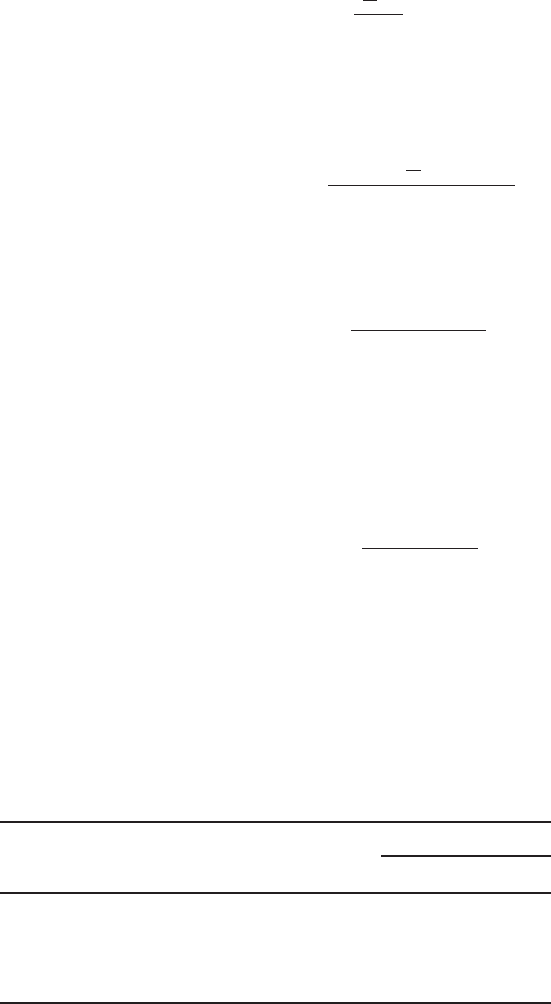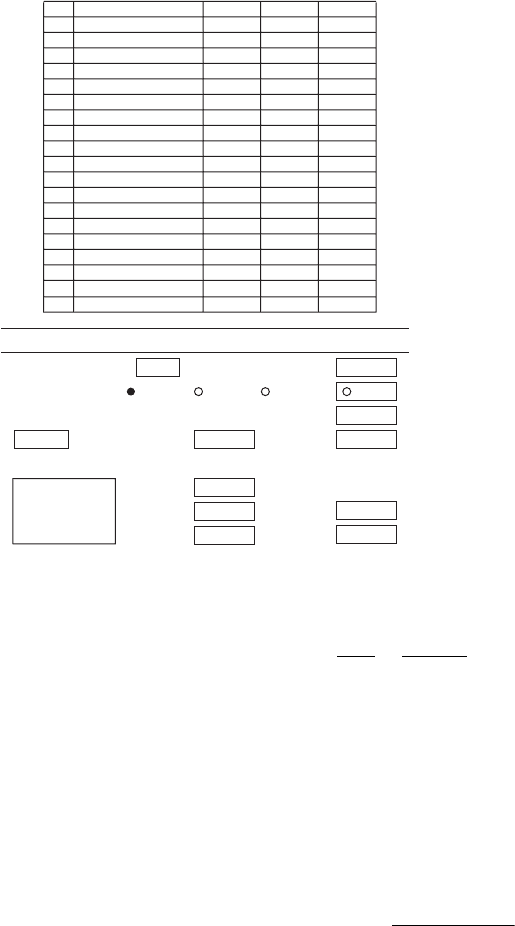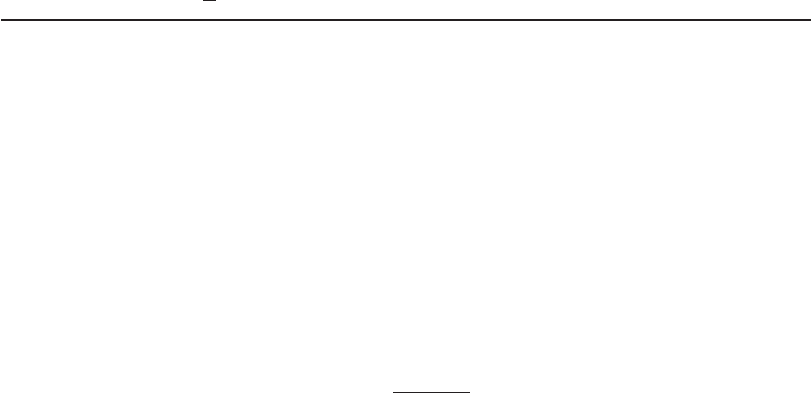Water and Wastewater Engineering
Подождите немного. Документ загружается.


23-18 WATER AND WASTEWATER ENGINEERING
The inverse of the left side of Equation 23-10 defines the mean cell residence time (
c
):
X
QX
wr
c
V
(23-12)
The mean cell residence time expressed in Equation 23-12 must be modified if the effluent
biomass concentration is not negligible. Equation 23-13 accounts for effluent losses of biomass
in calculating
c
:
c
wr w e
X
QX Q Q X
()()
V
(23-13)
From Equations 23-8 and 23-12 , it can be seen that once
c
i s selected, the concentration of
rbsCOD in the effluent ( S ) is fixed:
S
Kk
k
sdc
cm d
()
()
1
1
(23-14)
T ypical values of the microbial growth constants are given in Table 23-4 . Note that rbsCOD
leaving the system ( S ) is affected only by the mean cell-residence time and not by the amount of
BOD entering the aeration tank or by the hydraulic detention time.
The concentration of microorganisms in the aeration tank may be determ
ined from Equa-
tion 23-15 :
X
S
o
YS
k
c
dc
()( )
()1
(23-15)
In its essence,
c
i s the master variable for the design and operation of suspended growth
processes. It is the master variable because it is fundamentally related to the growth rate of the
active microorganisms, which in turn controls the concentration of the growth-rate-limiting
substance in the reactor. Furthermore,
c
t urns out to be an excellent choice as a master variable
because all of the parameters that comprise it can be measured accurately and consistently
(Rittmann and McCarty, 2001).
TABLE 23-4
Values of growth constants for domestic wastewater
Value
a
Parameter Basis Range Typical
K
s
mg/L BOD5 25–100 60
k
d
d
1
0–0.30 0.10
m
d
1
1–8 3
Y
mg VSS/mg BOD
5
0.4–0.8 0.6
a
Values are for 20 C
Sources: Metcalf & Eddy, 2003; and Shahriar et al., 2006.

SECONDARY TREATMENT BY SUSPENDED GROWTH BIOLOGICAL PROCESSES 23-19
Other useful relationships ( Equ ations 23-16 , 23-17 , 23-18 , 23-19 ) can be derived from this
model (Metcalf & Eddy, 2003). For example:
1
c
su
d
Y
r
X
k
(23-16)
or
1
c
(23-17)
where r
su
substrate utilization rate
specific biomass growth rate
In Equation 23-16 the term ( r
su
/ X ) is known as the specific substrate utilization rate, U. It may
be calculated as
U
r
X
QS S
X
SS
X
su
()
oo
V
(23-18)
S ubstitution of U into Equation 23-16 yields:
1
c
d
YU k
(23-19)
Batch Reactor
The principle batch reactor process is the sequencing batch reactor (SBR). The design principles
for this reactor are keyed to the following treatment steps (NEIWPCC, 2005):
• Fill. D uring this phase the basin receives influent wastewater. Three scenarios may be
selected:
• Static fill. In this scenario there is no mi
xing and no aeration while the wastewater is
entering the tank. This scenario is used during initial start-up of the facility. Static fill
may be used in plants that do not need to nitrify or denitrify to save power during low
flow periods.
• Mixed fill. In this scenario aeration is minimized by the use of mechanical or jet mixers.
Bec
ause there is no aeration, the was tewater/microorganism system becomes anoxic.
This is used to promote denitrification. Anaerobic conditions can also be achieved to
promote the release of phosphorus.
• Aerated fill. In this scenario both aerators and mechanical mixing may be emplo
yed.
In batch processes the oxygen uptake rate is a factor of concern for two reasons. First,
the cell concentration is very high at the beginning of fill, and, second, the maximum reac-
tor BOD concentration also occurs at this time.

23-20 WATER AND WASTEWATER ENGINEERING
From a design perspective, this mode of filling requires a significantly higher air sup-
ply than is required in subsequent steps. Thus, the aeration system is overdesigned for the
majority of the operating sequence. Two alternatives are available. One is to begin with a
mixed fill (anoxic) and then switch to an aerated fill after som
e portion of the wastewater
has been added. The other alternative is to provide a feedback control to decrease the air
flow rate and energy consumption in subsequent steps (Schroeder, 1982).
• React. D uring this phase aeration and mixing units are on. No wastewater enters the basin.
Most carbonaceous BOD removal occurs during this phase. With an appropriate aeration
du
ration, nitrification will also occur in this phase. If anaerobic fill is employed, the phos-
phorus released during fill plus some additional phosphorus is taken up during this phase.
• Settle. Air and mixing are turned off. The activated sludge is allowed to settle. This is a
critical step both for the recovery of biom
ass for the next cycle and the production of an
effluent that is low in suspended solids.
• Decant. A decanter is used to remove the clear supernatant that is to be discharged. It needs
to remove clear liquid without entrapping surface scum or entraining settled sludge.
• Idle. This step occur
s between the decant and fill phases. Depending on the flow rate,
this phase may be long or short. At high flow rates, this phase may be eliminated. At low
flow rates, this phase may be very long. If this phase is too long, the sludge may become
anaerobic.
Batch Reactor Model. The change in substrate concentration with time in a batch reactor can
be determined b
y starting with the substrate mass balance for a CSTR (Metcalf & Eddy, 2003):
dS
dt
QS QS r
su
o
V
V
(23-20)
where
r
SX
YK S
su
m
s
()
Other terms are the same as those defined previously.
Because Q = 0 for a batch reactor, Equation 23-20 can be simplified to
dS
dt
SX
YK S
m
s
()
(23-21)
Integration of Equation 23-21 with respect to time yields
K
S
o
S
SS
o
X
Y
t
s
t
t
m
ln
⎛
⎝
⎜
⎞
⎠
⎟
⎛
⎝
⎞
⎠
()
(23-22)
where S
o
initial substrate concentration at time t 0, mg/L
t time, d
S
t
substrate concentration at time t, mg/L

SECONDARY TREATMENT BY SUSPENDED GROWTH BIOLOGICAL PROCESSES 23-21
For nitrification, the Monod kinetic coefficients (Chapter 22, Equation 22-28) are substituted in
Equation 23-22 :
K
N
N
NN X
Y
DO
KDO
n
t
tn
mn
n
ln
o
o
0
⎛
⎝
⎜
⎞
⎠
⎟
⎛
⎝
⎜
⎞
⎠
⎟
()
⎛⎛
⎝
⎜
⎞
⎠
⎟
t
(23-23)
The terms in this equation are defined in Chapter 22.
The batch kinetic equations can be used to determine if the react period aeration time se-
lected is sufficient to provide the desired amount of degradation. Because X and t are unknown,
an iterative solution is required. Metcalf & Eddy (2003)
suggests using an overall mass balance
to estimate X or X
n
based on an assumed substrate consumption.
It should be noted that sludge age does not appear in Equations 23-22 or 23-23 . Nonetheless,
the design is based on m icrobial biochemistry and microbial population dynamics. The SRT is
used to develop the values for
X or X
n
in Equations 23-22 or 23-23 .
Plug Flow with Recycle Model
Although it is difficult to achieve true plug flow, many long, narrow aeration tanks may be better
approximated by plug flow than by completely m ixed models. A kinetic model of a plug-flow
system is difficult to develop from basic mass balance equations. With two simplify
ing assump-
tions, Lawrence and McCarty (1970) developed a useful equation. The assumptions are:
1 . The concentration of microorganisms in the influent to the aeration tank is approxi-
mately the same as that in the effluent from the aeration tank. This assumption applies if
c
/ is greater than 5.
2. The rate of soluble BOD
5
utilization as the waste passes through the aeration tank is
given by
r
SX
K S
u
m
s
avg
(23-24)
where X
avg
is the average concentration of microorganisms in the tank.
The design equation is
1
1
c
m
s i
S
o
YS
SS
o
RR K S S
()
()()()
−
ln /
(23-25)
where RR recycle ratio, Q
r
/ Q
ln logarithm to base e
S
i
influent concentration to aeration tank after dilution with recycle flow, mg/L
RS
o
RS
RR1
()
(23-26)
Other terms are the same as those defined previously.
Safety Factor
There is a value of
c
below which waste will not be stabilized. This is called the critical mean cell
residence time (
c min
). Physically,
c min
i s the residence time at which the cells are washed out or

23-22 WATER AND WASTEWATER ENGINEERING
wasted out of the system faster than they can reproduce. When washout occurs S = S
o
.
c min
can
be estimated by making this substitution in Equation 23-19 :
1
c
m
s
d
S
o
S
o
K
k
min
()
(23-27)
Because S
o
is typically much greater than K
s
, Equation 23-27 may be rewritten as
1
c
md
k
min
(23-28)
To minimize the potential for plant failure, plant design/operation must avoid
c min
. The
suggested approach is to select a design
c
that is a multiple of
c min
(Christensen and McCarty,
1975). The safety factor is then defined as
SF
c
c
-design
-min
(23-29)
The implied safety factors are shown in Table 23-5 . High-rate i mplies that the skill of the opera-
tor and system oversight is exceptional. Low-rate implies limited operator attention.
A k e y point is that the safety factors for the model are very high even with the best systems.
Evaluation of Assumptions
The assumptions of either CSTR or plug-flow reactors are seldom achieved in real systems. Thus,
these models only serve as a starting point for evaluation and design. It is also important to reem-
phasize that S i s rbsCOD, that is, the soluble COD that is readily biodegradable and not the total
BOD. Some fraction of the suspended
solids that do not settle in the secondary settling tank also
contributes to the BOD load to the receiving body. To achieve a desired effluent quality, both the
soluble and insoluble fractions of BOD must be considered. Thus, to use Equations 23-14 , 23-15 ,
2 3-18 , 23-19 , 23-21 , or 23-25 to achieve a
desired effluent quality ( S ) by solving for
c
or t, some
estimate of the biodegradable COD (bCOD) or BOD of the suspended solids must be made first.
The BOD of the suspended solids is subtracted from the total allowable BOD in the effluent to
find the allowable S:
S Total BOD allowed BOD in suspended solids
(23-30)
Loading Implied SF
Conventional 10–80
High-rate 3–10
Low-rate >80
TABLE 23-5
Implied safety factors for typical
biological treatment design loadings
Source: Rittmann and McCarty, 2001.

SECONDARY TREATMENT BY SUSPENDED GROWTH BIOLOGICAL PROCESSES 23-23
The development of these equations assumes that there are no reactions in the settling tank.
Because the mass of microorganisms in the settling tank is quite large, this assumption may
result in a significant error in estimating
V
. If the settling tank has significant reactions, then
V
in the model equations becomes the sum of the volume in the aeration tank and the settling tank.
Assuming that the volumes may be added is a significant assumption. In general, prudent engi-
neering practice requires a more conservative assumption.
E xample 23-1 illustrates the estimation of the volume of a completely mixe
d activated tank
for BOD
5
oxidation.
Example 23-1. The town of Lawrenc e has been directed to u pgrade its primary WWTP to
a secondary plant that can meet an effluent standard of 30.0 mg/L BOD
5
and 30.0 mg/L total
suspended solids (TSS). They have selected a completely mixed activated sludge system.
Assuming that the BOD
5
of the TSS may be estimated as equal to 63% of the TSS concentra-
tion, estimate the required volume of the aeration tank. The following data are available from the
existing primary plant.
Existing primary plant effluent characteristics
Flow = 12,960 m
3
/ d
BOD
5
= 84.0 mg/L
A ssume the following values for the growth constants: K
s
100 mg/L BOD
5
;
m
2.5 d
1
;
k
d
0.050 d
1
; Y 0.50 mg VSS/mg BOD
5
removed. Also assume that the secondary clarifier
can produce an effluent with 30.0 mg/L TSS, and that MLVSS 2,000 mg/L.
Solution:
a . Estimate the allowable soluble BOD
5
in the effluent using the 63% assumption from
above and Equation 23-30 .
S 300 063300 111... .mg/L mg/L mg/L()( )
b. The mean cell-res idence time can be estimated with Equation 23-14 and the assumed
values for the growth constants.
11 1
100 0 1 0 050
5
1
.
..d
()(()()
(
mg/L BOD
c
c
225 00501
11
. d . d
)
Solving for
c
()( )11 1 2 45 1 100 0 5 00
27 20 11
.. . .
..
cc
c
11 100 0 5 00
111 1
22 2
5 00 5 0
..
.
.
..or d
c
c
c. Using the assumed value of 2,000 mg/L for the MLVSS, solve Equation 23-15 for the
hydraulic detention time.

23-24 WATER AND WASTEWATER ENGINEERING
2 000
5 00 0 50840
5
,
.. .
mg/L
dmg VSS/mgBOD
()(
mg/L mg/L
d
11 1
10050 5 00
1
.
..
)
( ( )( ))
d
2250729
2 000 1 25
0 0729 1 75
..
.
..
()
(),
d or h
The volume of the aeration tank is then estimated using Equation 23-11 :
0 0729
12 960
944 78 945
3
3
.
,
.
d
m /d
or m
V
V
Comment. Two tanks of this size are required to meet redundancy requirements.
Sludge Return
A mong the major decisions in developing a suspended growth reactor design is the selection of
the mixed liquor volatile suspended solids (MLVSS) concentration and the corresponding mixed
liquor suspended solids (MLSS) concentration. This selection is not simple. It
depends on the
objective of the reactor, settling characteristics of the sludge, and the rate of recycle of sludge
(called the sludge return rate or sludge return, or return activated sludge —RAS).
A high MLVSS concentration is desirable because it leads to a smaller reactor and lower
construction costs. But this may lead to a larger settling tank to handle the s
ludge load. In addi-
tion, a higher MLVSS also requires a higher aeration rate to meet the increase in oxygen demand.
Increasing MLVSS also requires increasing the rate at which sludge is returned from the settling
tank. Finally, a higher MLVSS may lead to a higher effluent suspended solids and BOD in the
effluent.
A mass balance around
the settling tank in Figure 23-9 is the basis for selecting a return sludge
rate. Assuming that the amount of sludge in the secondary settling tank remains constant (steady-
state conditions) and that the effluent suspended solids ( X
e
) are negligible, the mass balance is
accumulation inflow outflow
(23-31)
0 # # #()()( )QQX QX QX
rrrwr
(23-32)
where Q wastewater flow rate, m
3
/ d
Q
r
return sludge flow rate, m
3
/ d
X
#
mixed liquor suspended solids (MLSS), g/m
3
X
r
#
maximum return sludge concentration, g/m
3
Q
w
sludge wasting flow rate, m
3
/ d
Solving for the return sludge flow rate:
Q
QX Q X
XX
r
wr
r
# #
# #
(23-33)

SECONDARY TREATMENT BY SUSPENDED GROWTH BIOLOGICAL PROCESSES 23-25
Using Equation 23-12 , this may be rewritten as
Q
QX
X
XX
r
c
#
#
# #
⎛
⎝
⎜
⎞
⎠
⎟
r
V
(23-34)
Frequently, the assumption that the effluent suspended solids are negligible is not valid. If the
effluent suspended solids are significant, the mass balance may then be expressed as
0 ()()( )( )QQX Q
X
Q
X
QQX
rr
r
w
r
we
(23-35)
Solving for the return sludge flow rate gives
Q
QX Q
X
QQX
X
X
r
w
r
we
r
()
(23-36)
Note that X
r
and X
include both the volatile and inert fractions. Thus, they differ from X
r
and
X b y a constant factor. It is generally assumed that VSS is 60 to 80 percent of MLVSS. Thus,
MLSS may be estimated by dividing MLVSS by a factor of 0.6 to 0.8 (or multiplying by 1.25 to
1.67).
With the volume of the tank and the mean cell-residence time, the sludge wasting flow rate
can be determined with Equation 23-12 if the ma
ximum return sludge concentration ( X
r
# ) can be
determined. Operating experience has demonstrated a range of values for X
r
#
. For a typical good
settling sludge the maximum X
r
#
i s in the range of 10,000 to 14,000 mg/L. With poorly settling
sludges the maximum X
r
#
may be as low as 3,000 to 6,000 mg/L.
For operational flexibility the return sludge pumping rate must be adjustable. Typically, the
maximum sludge return rate is set equal to the design flow rate. Example 23-2 illustrates the
estimation of a maximum RAS flowrate.
Example 23-2. Determine the return slu
dge concentration ( X
r
#
) that results in the maximum
return sludge flow rate for the proposed activated sludge upgrade at Lawrence ( Example 23-1 ).
Also estimate the mass flow rate of sludge wasting. Use the following assumptions: MLVSS
fraction of MLSS 0.70 and volume of aeration tank 950 m
3
.
Solution:
a . The Solver * program in a spreadsheet was used to perform the iterations for solution of
this problem. The spreadsheet cells are shown in Figure 23-10 . The cell locations used in
the figure are identified by brackets [ ] in the discussion below.
b . Begin with the average design flow by setting the fixed parameters as follows:
[ B
5] Q 12,960 m
3
/ d
[B6] MLVSS 2.0 g/L
[B7] MLVSS fraction 0.70
* Solver is a “tool” in Excel
®
. Other spreadsheets may have a different name for this program.

23-26 WATER AND WASTEWATER ENGINEERING
c. In cell [B8] write an equation to convert MLVSS to MLSS.
[]
[]
B
B
g/L
g/L
6
7
20
07
286
.
.
.
d. Continue setting the fixed parameters from Example 23-1 :
[B9] Volume of aeration tank 950 m
3
[B10]
c
or SRT 5.0 d
[B11] X
e
#
0.030 g/L
e. In cell [B15] insert a guess at X
r
#
between 3 and 20 g/L.
f. In cell [B17] calculate Q
w
.
([ ] [ ])
([ ] [ ]
)
BB
BB
98
10 15
∗
∗
g. Activate the dialog box for solver and designate the target cell as [B19], that is, the one
for the return sludge flow rate.
h. Set Equal to to “Max.”
i. Set By changing to the cell containing the return sludge MLSS ( X
r
#
), that is, [B15].
A BCD
Input Data
Q =
m
3
/d
m
3
/d
m
3
/d
MLVSS =
12960
96.2
12960.0
MLVSS fraction =
MLSS
X’
e
=
X
r
’ =
Volume of AT =
SRT =
Q
w
=
Q
w
X
r
’ =
Q
r
=
Calculation of Q
r
and X
r
’
3
4
5
6
7
8
9
10
11
12
13
14
15
16
17
18
19
20
21
2
g/L
0.7
2.86
g/L
950
5
0.03
5.64
542 .9 kg/d
d
g/L
g/L
This is X’
Solver parameters
Set target cell: $B$19 Solve
Close
OptionsGuess$B$15
Add
Change
Delete
Equal to:
By changing cells:
Subject to the constraints:
$B$19
= $B$5
Reset all
Help
Max. Value of:Min.
m
3
FIGURE 23-10
E xample 23-2 spreadsheet with solver dialog box.

SECONDARY TREATMENT BY SUSPENDED GROWTH BIOLOGICAL PROCESSES 23-27
j. Add the following constraint in the dialog box: [B19] = [B5].
k. Execute solve to find:
X
r
#
= 5.64 g/L
Q
w
= 96.2 m
3
/ d
Q
r
= 12,960 m
3
/ d
Q
w
X
r
#
= 542.9 kg/d
Comments:
1 . Although an algebraic solution is possible, the spreadsheet solver func tion is a conve-
nient tool for the solution.
2. The spreadsheet can be used without the solver tool to explore the other relationships,
that is, X
r
#
, Q
w
, Q
r
, and Q
w
X
r
#
.
Sludge Production
An estimate of the sludge production is important for process design of the sludge handling facilities
and the aeration system. As a suspended growth process removes substrate, the substrate is con-
verted into new cell material. This cell material is activated sludge. The slu
dge will accumulate in
the process if it cannot be processed by the sludge handling facility. Eventually, the sludge inventory
will exceed the capacity of the system and will exit the secondary clarifier as suspended solids.
The estimate of the amount of oxygen req
uired for biodegradation of carbonaceous BOD is
determined from a mass balance of the bCOD concentration and the amount of biomass wasted
from the system. The amount of biomass wasted is a function of the amount of sludge produced.
Two methods of estimating the s
ludge production are used. The first is satisfactory for pre-
liminary design. It is based on rules-of-thumb and published data from existing facilities. In this
method the net activated sludge produced each day is determined b
y:
Y
Y
k
dc
obs
1
(23-37)
and
PYQSS
x
obs
kg/g()( )
o
10
3
(23-38)
where P
x
net waste activated sludge produced each day in terms of VSS, kg/d
Y
obs
observed yield, kg MLVSS/kg BOD
5
removed
Other terms are as defined previously.
The amount of sludge that must be wasted each day is the difference between the amount of
increase in sludge mass and the total suspended solids (TSS) lost in the effluent:
Mass to be wasted increaseinMLSS TSSlostin effluent
(23-39)
The increase in MLSS may be estimated by assuming that VSS is some fraction of MLSS. It
is generally assumed that VSS is 60 to 80 percent of MLVSS. Thus, the increase in MLSS may
be estimated by dividing P
x
b y a factor of 0.6 to 0.8 (or multiplying by 1.25 to 1.67). The mass of
